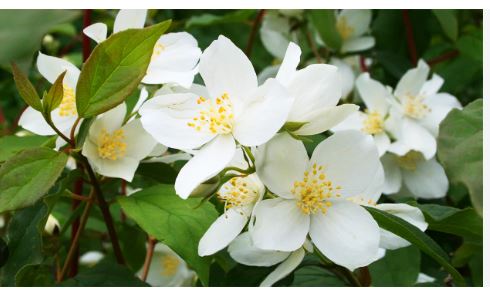
Philadelphus lewisii, commonly known as Lewis’ Mock Orange or Syringa, is a member of the Philadelphus genus in the Hydrangeaceae family, which was previously classified under the Saxifragaceae family. This species is known for its fragrant, white, four-petaled flowers that give off a scent reminiscent of orange blossoms, hence the common name “Mock Orange.” The species name “lewisii” honors Meriwether Lewis of the Lewis and Clark Expedition, who first described this plant.
Lewis’ Mock Orange is native to western North America, specifically found from British Columbia in Canada, through Washington, Oregon, Idaho, Montana, and into parts of California and Nevada. It naturally occurs in a variety of habitats, from open woods, stream banks, to the edges of forests, preferring moist, well-drained soils in sun or light shade.
Historically, Philadelphus lewisii has been significant to indigenous peoples, who used its wood for tools, its bark for medicinal purposes, and its flowers for their fragrance in ceremonies or as a tea. The Lewis and Clark Expedition’s documentation of this plant brought it wider recognition, and it was one of the species that sparked interest in American flora among botanists and horticulturists. Over time, it has become a popular ornamental shrub in gardens across its native range and beyond due to its beautiful flowers and delightful fragrance. In 1931, it was adopted as the state flower of Idaho, reflecting its regional importance and beauty.
Lewis’ Mock Orange is adapted to USDA Hardiness Zones 3 through 8, indicating its resilience to a range of climates, from the cold winters of the northern parts of its range to the milder conditions in the south. It can live for many years, often reaching several decades in good conditions, with some shrubs potentially lasting over 50 years. Its longevity is supported by its hardy nature, ability to thrive in various light conditions, and its role in stabilizing soil in natural settings.
Syringa (Mock Orange) (Philadelphus lewisii): Characteristics
- Flower Appearance: Produces clusters of white, four-petaled flowers that are highly fragrant, reminiscent of orange blossoms. Flowers are about 1 to 2 inches across, blooming in late spring to early summer.
- Bloom Time: Blooms in late spring, with the display lasting several weeks, providing a strong, sweet scent throughout the garden or woodland area.
- Growth Habit: Grows as a deciduous shrub with an upright, often arching form, reaching heights of 6 to 12 feet, sometimes more, with a spread that can be nearly as wide, forming dense thickets.
- Leaves: Features opposite, ovate to lance-shaped leaves that are a rich green, turning yellow in the fall. Leaves are 1 to 3 inches long, adding to the shrub’s year-round appeal.
- Bark: Has attractive, shredding bark that can be reddish to brown, adding winter interest and texture to the landscape.
- Root System: Develops a fibrous root system that allows for stability and effective nutrient uptake, capable of spreading through suckers in favorable conditions.
- Adaptability: Adaptable to various soil types but prefers well-drained, moist soils. It thrives in full sun to partial shade, with more flowers in sunnier locations.
- Pollinator Attraction: Attracts bees, butterflies, and other pollinators with its nectar-rich flowers, contributing to local biodiversity and pollination.
- Fragrance: Its flowers emit a strong, sweet scent, making it a popular choice for areas where fragrance is desired, like near patios or walkways.
- Ecological Role: Provides habitat for wildlife, with its dense growth offering nesting sites for birds. Its flowers support pollinators, and the plant helps in soil stabilization, particularly along streambanks.
Syringa (Mock Orange) (Philadelphus lewisii): Cultivation
Site Selection
Select a location with full sun to partial shade. While it can bloom well in full sun, partial shade is beneficial in hotter climates to prevent leaf scorch.
Soil Preparation
Prefers well-drained, moist soil but is adaptable to a range of soil types. Enhance heavy or sandy soils with organic matter to improve texture and moisture retention.
Planting
Plant in spring or fall, spacing plants 6 to 10 feet apart to allow for growth. Dig a hole twice as wide as the root ball, ensuring the root crown is level with or slightly above the soil surface.
Watering
Water deeply after planting to establish roots. Once established, it’s relatively drought-tolerant but benefits from deep watering during prolonged dry periods, especially in its first few years.
Mulching
Apply mulch around the base to conserve soil moisture, suppress weeds, and regulate soil temperature. Use organic mulch like wood chips, keeping it away from the stem to prevent rot.
Fertilization
Fertilize in early spring with a balanced, slow-release fertilizer. Avoid over-fertilizing, as this can lead to lush foliage at the expense of flowers.
Pruning and Maintenance
Prune immediately after flowering to shape or thin out the shrub, removing dead or overcrowded branches. This encourages more blooms the following year since it flowers on old wood.
Pest and Disease Management
Generally hardy, but watch for aphids, scale insects, or powdery mildew in overly wet conditions. Ensure good air circulation and avoid overwatering to prevent diseases.
Propagation
Propagate through softwood cuttings in late spring to early summer or by layering. Seeds can be used but are less reliable for maintaining desirable traits.
Winter Care
In its native range, no special winter care is typically required due to its hardiness. However, in colder zones at the edge of its range, a light mulch can protect roots from extreme cold.